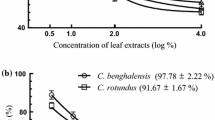Abstract
Allelopathic effects of entire shoot extract, plant part extracts, and shoot residue of parthenium (Parthenium hysterophorus L.) on corn (Zea mays L.), ryegrass (Lolium multiflorum Lam.), wheat (Triticum aestivum L.), velvetleaf (Abutilon theophrasti Medik.), and soybean [Glycine max (L) Merr.] growth were examined. Parthenium shoot contained water-soluble materials that were toxic to root growth of velvetleaf and wheat. At 4% (w/ v) concentration, root growth of velvetleaf and wheat were reduced by 60 and 75%, respectively. The order of increasing sensitivity to parthenium was ryegrass, corn, wheat, and velvetleaf. There was a strong correlation between extract concentration and increased toxicity to test species. The toxicity of plant part extracts was also concentration dependent. At 1 and 2% (w/v), the inflorescence and leaves caused more root inhibition than stem extract. Parthenium shoot incorporated in soil at 1% (w/w) caused significantly more root inhibition of wheat than soybean, corn, and ryegrass. At 4% (w/w), root growth of all the test species was inhibited compared to the control. Toxicity of parthenium residue to wheat diminished with increasing periods of decomposition. Residue decomposed for four weeks was less toxic than the undecomposed residue.
Similar content being viewed by others
References
Abdul-Wahab, A.S., andRice, E.L. 1967. Plant inhibition by johnson grass and its possible significance in old-field succession.Bull. Torrey Bot. Club 94:486–497.
Achhireddy, N.R., andSingh, M. 1984. Allelopathic effects of lantana (Lantana camara) on milkweed vine (Morrenia odorata).Weed Sci. 32:757–761.
AlSaadawi, I.S., andRice, E.L. 1982. Allelopathic effects ofPolygonum aviculare L. I. Vegetational patterning.J. Chem. Ecol. 8:993–1009.
Avers, C.J., andGoodwin, R.H. 1956. Studies on roots IV. Effects of coumarin and scopoletin on the standard root growth pattern ofPhleum pratense.Am. J. Bot. 43:612–620.
Bhowmik, P.C., andDoll, J.D. 1982. Corn and soybean response to allelopathic effects of weed and crop residues.Agron. J. 74:601–606.
Caussanel, J.P. 1979. Noncompetitive effects between lambsquarters (Chenopodium album L.) and maize (INRA 258).Weed Res. 19:123–135.
Fay, P.K., andDuke, W.B. 1977. An assessment of allelopathic potential inAvena germ plasm.Weed Sci. 25:224–228.
Grummer, G., andBeyer, H. 1960. The influence exerted by species ofCamelina on flax by means of toxic substances, pp. 153–157,in J.L. Harper (ed.). The Biology of Weeds. Blackwell Scientific, Oxford.
Guenzi, W.D., andMcCalla, T.M. 1962. Inhibition of germination and seedling development by crop residues.Proc. Soil Sci. Am. 26:456–458.
Guenzi, W.D., McCalla, T.M., andNorstadt, F.A. 1967. Presence and persistence of phytotoxic substances in wheat, oat, corn and sorghum residues.Agron. J. 59:163–165.
Kaminsky, R. 1981. The microbial origin of the allelopathic potential ofAdenostoma fasciculatum.Ecol. Monogr. 51:365–382.
Kanchan, S.D., andJayachandra 1979a. Allelopathic effects ofParthenium hysterophorus. I. Exudation of inhibitors through roots.Plant Soil 53:27–35.
Kanchan, S.D., andJayachandra 1979b. Allelopathic effects ofParthenium hysterophorus. II. Leaching of inhibitors from aerial vegetative parts.Plant Soil 53:61–66.
Kimber, R.W. 1973. Phytotoxicities from plant residues II. The effect of time of rotting of straw from some grasses and legumes on the growth of wheat seedings.Plant Soil 38:347–361.
Kozel, P.C., andTukey, H.B., Jr. 1968. Loss of gibberellins by leaching from stems and foliage ofChrysanthemum morifolium “Princess Anne”Am. J. Bot. 55:1184–1189.
Linderman, R.G. 1970. Plant residue decomposition products and their effects on host roots and fungi pathogenic to roots.Phytopathology 60:19–22.
Muller, C.H. 1965. Inhibitory terpenes volatized fromSalvia shrubs.Bull. Torrey Bot. Club 92:38–45.
Muller, C.H., Muller, W.H., andHans, B.L. 1964. Volatile growth inhibitors produced by shrubs.Science 143:471–473.
Overland, L. 1966. The role of allelopathic substances in the smother crop barley.Am. J. Bot. 53:423–432.
Patrick, Z.A. 1971. Phytotoxic substances associated with the decomposition in soil of plant residues.Soil Sci. 111:13–18.
Patrick, Z.A., Toussoun, T.A., andSnyder, W.C. 1963. Phytotoxic substances in arable soils associated with the decomposition of plant residues.Phytopathology 53:152–161.
Picman, J., andPicman, A.K. 1984. Autotoxicity inParthenium hysterophorus and its possible role in control of germination.Biochem. Syst. Ecol. 10:287–292.
Sarma, K.K.V., Giri, G.S., andSubramanyam, K. 1976. Allelopathic potential ofParthenium hysterophorus Linn. on seed germination and dry matter production inArachis hypogea Willd.,Crotalaria juncea Linn. andPhaseolus mungo Linn.Trop. Ecol. 17:76–77.
Schon, M.K., andEinhellig, F.A. 1982. Allelopathic effects of cultivated sunflower on grain sorghum.Bot. Gaz. 143:505–510.
Tomaszewski, M., andThimann, K.V. 1966. Interactions of phenolic acids, metallic ions and chelating agents on auxin induced growth.Plant Physiol. 41:1443–1454.
Tukey, H.B., Jr. 1966. Leaching of metabolites from above ground plant parts and its implications.Bull. Torrey Bot. Club 93:385–401.
Woods, F.W. 1960. Biological antagonism due to phytotoxic root exudates.Bot. Rev. 26:546–549.
Author information
Authors and Affiliations
Additional information
Florida Agricultural Experiment Stations Journal Series No. 7506.
Rights and permissions
About this article
Cite this article
Mersie, W., Singh, M. Allelopathic effect of parthenium (Parthenium hysterophorus L.) extract and residue on some agronomic crops and weeds. J Chem Ecol 13, 1739–1747 (1987). https://doi.org/10.1007/BF00980214
Received:
Accepted:
Issue Date:
DOI: https://doi.org/10.1007/BF00980214




